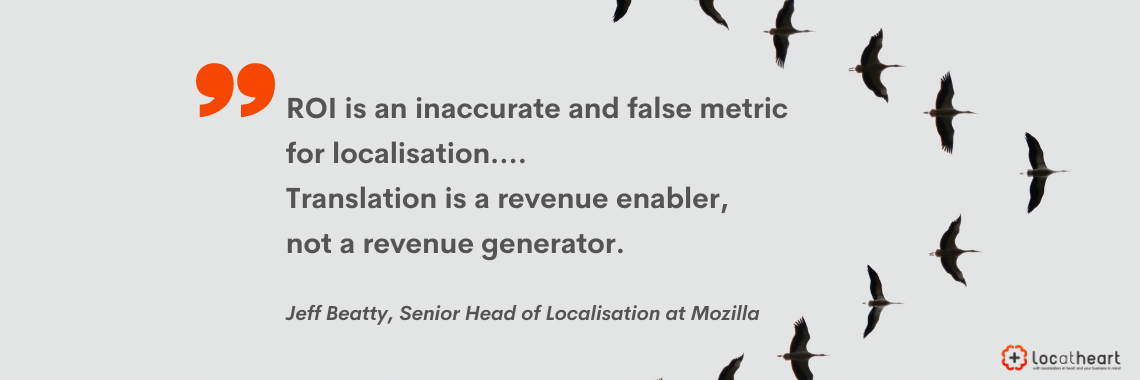Translation and localisation ROI
Business demands gain. Investments must be profitable. That is why you calculate translation ROI. Localisation, too, must bring about measurable effects – “measurable” being the key word.
Problem with calculating ROI for translations

This statement pretty much sums up the issue with estimating the impact that translations have on profit. The effectiveness of translation always depends on the quality of work done beforehand – for example that related to customer segmentation, UX research, back-end and front-end, and even page loading time.
It is not surprising, then, that many of us would simply want to forgo carrying out profit-based assessments of translations.
Translation as an “activator”
According to Jeff Beatty, Senior Head of Localisation at Mozilla, “ROI is an inaccurate and false metric for localisation…. Translation is a revenue enabler, not a revenue generator”.
The use of a foreign language can be an insurmountable obstacle for customers – hence, for a business, it is a barrier to entry that must be overcome to reach such customers (more on this here). Translation allows a company to establish a relationship with foreign customers and enables it to gain revenue in new markets.
But is it a sufficient reason for giving up on measuring translation ROI, or, in other words – how investing in new language versions relates to profit?
Calculating translation ROI
The cost of translation and localisation for a specific market as a percentage of revenue gained from this market.
When we enter a market, the number will be high. Texts must be translated from scratch, while revenue is low. However, after some time, the new language version should become more profitable. Updates will be smaller than the “initial content package”, and revenue will begin to increase. In this scenario, the cost-to-revenue ratio will decrease.
There are many more similar – indirect – ways to measure the effectiveness of investing in translation and translation ROI. They are indirect because, just like all attribution models, they are largely arbitrary, so assigning specific financial values to intertwined aspects (such as textual, technical and logical elements of a website) is based on decisions backed with incomplete data.
The only certain thing is the cost of no translation.
Cost of no translation
Studies indicate that most customers are willing to buy a more expensive product in their preferred language version instead of a cheaper one in a foreign language. The more expensive and complex an item is, the more importance customers attach to localisation. No translation means no sales. And how does quality fit in?
Cost of bad translations
What’s the cost of an incorrect comma or wrong declension? What price do you have to pay for a Czech word that has somehow “ended up” in a Slovak text? In some countries, customers pay a lot of attention to correctness, while in others – such as Czechia and Slovakia – historical aspects may be a sensitive matter. Still, even with no such complications, it’s easy to imagine how a bad-quality translation may ruin the efforts of innumerable individuals and departments.
Example: Your company has launched an excellent product, the fruit of hard work put into the analysis of consumer needs and subsequent tests. A renowned agency has prepared an ideal strategy. Costs and margins have been meticulously calculated. Communication and marketing experts have been hired, and – in collaboration with the best copywriters in the industry – they have created superb texts.
Then, because of a poor translation, in the new market:
What a beautiful disaster – and a plausible one too!
Sure, it’s unlikely that all these problems would occur – after all, someone is watching over the whole process. Still:
The linguistic layer has an influence on the ease of using websites and apps – and thus on meeting sales goals. “Broken” linguistic layer “breaks” the sales channel and diminishes its efficiency.
Lightening holes
Imagine that a standard, satisfactory translation is like a normal, good car. You can use it to “deliver” results to a new market.
Every linguistic mistake is an additional weight for the car – with different errors having different weight – and makes it harder for you to drive fast and safe.
But you want your car to be lighter and faster! You need results!
A professional and optimised translation is like your car’s lightening holes. You don’t have to own a Porsche or turn your car into a sieve. We’ll help you determine which holes really pay off!





![Customer self-service in the digital age [featured image] - translation agency LocAtHeart](https://locatheart.com/wp-content/uploads/2021/11/1-450x231.png)
Leave a Reply